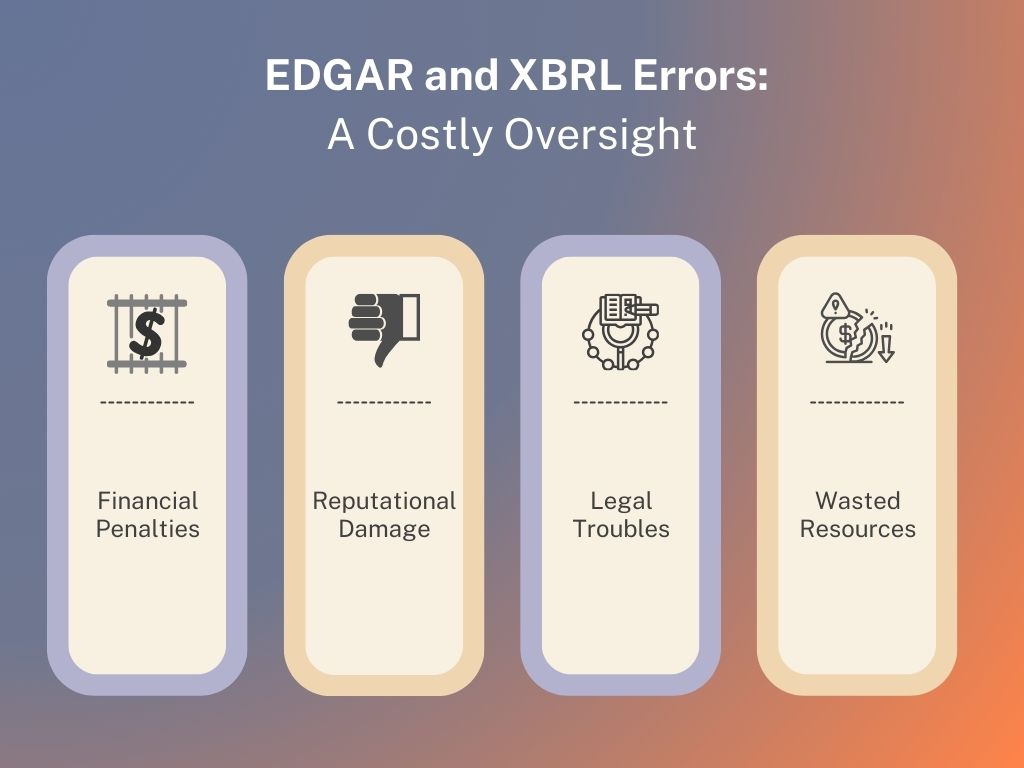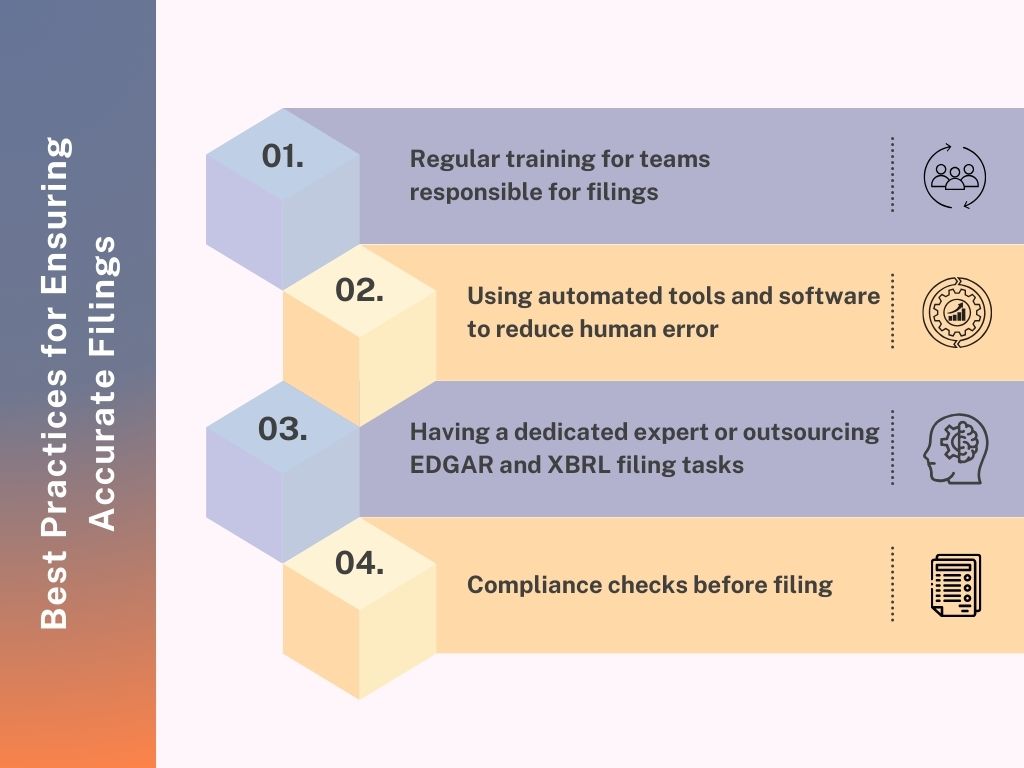Ever feel like navigating the world of regulatory filings is like trying to decipher ancient hieroglyphics? You’re not alone!
When it comes to the Securities and Exchange Commission (SEC), getting your ducks in a row with EDGAR filing and XBRL tagging isn’t just a good idea – it’s crucial. Mess it up, and you might find yourself facing some surprisingly hefty costs.
Trust us, these aren’t the kind of surprises anyone enjoys.
Understanding the Basics: EDGAR and XBRL in a Nutshell
Let’s simplify these two acronyms, which tend to confuse even the most experienced individuals in the field. Think of them as two sides of the same coin when it comes to reporting your company’s vital information to the SEC.
What is EDGAR? Your Digital Filing Cabinet with the SEC
Imagine a giant, super-organized digital filing cabinet – that’s essentially what EDGAR (Electronic Data Gathering, Analysis, and Retrieval system) is. It’s the SEC’s primary system for companies to electronically submit required filings, from annual reports (10-K) to quarterly updates (10-Q) and everything in between. It’s how the SEC keeps tabs on publicly traded companies and ensures transparency for investors. So, getting your documents into this digital cabinet correctly is the first big hurdle.
EDGAR: Beyond the Basics
So, you’ve wrapped your head around what EDGAR is. Great! Now let’s pull back the curtain a bit further and get into the nuts and bolts of how it all actually works. Spoiler alert: it’s not as scary as it sounds — unless you really hate acronyms and file formats.
How EDGAR Works (A Technical Overview)
Think of EDGAR like a picky digital librarian — it doesn’t just want your documents; it wants them a certain way. Knowing the preferred file formats and submission structure is half the battle.
File types and formats (HTML, ASCII, XML, PDF support):
EDGAR is a fan of structure and clarity, which means it plays nice with specific formats only. HTML is the preferred format for filings, but ASCII and XML are also acceptable for certain data-heavy submissions. PDFs? Those are okay too — but mostly for unofficial copies or exhibits, not your main filing content. Don’t try sneaking in a Word document or a fancy PowerPoint; they’ll get shown the door.
Structure of a submission (cover sheets, exhibits, signatures):
Each filing has a set layout. You start with a submission header (like a digital cover sheet), then move on to the main document (e.g., your 10-K), followed by any required exhibits. Signatures go in too — just make sure they’re formatted properly, or the SEC will give you the digital equivalent of a red pen correction.
Use of EDGARLink Online vs. private software:
EDGARLink Online is the SEC’s own filing tool, mainly suited for smaller or occasional filers. It requires users to upload EDGAR-compliant HTML and any supporting documents (such as PDFs) directly — it does not offer a Word-to-HTML conversion feature. For filers managing larger volumes or seeking automation, private third-party software often provides more advanced tools, including Word-to-HTML conversion, stronger validations, and greater flexibility. Just be sure that any third-party software you use is fully EDGAR-compliant — even the most sophisticated features won’t help if the SEC rejects your submission.
Live vs. Test Filings: Avoiding Public Mistakes
Ever wish you could do a dress rehearsal before going live? Good news: EDGAR lets you.
What a test filing is and when to use it:
Test filings (also known as “practice runs”) let you simulate a real submission without publishing anything publicly. It’s your chance to catch errors, see how your filing would be received, and double-check formatting before your CFO sees their name attached to a document with broken links.
Common mistakes in live submissions (metadata, timestamp, encoding):
Submitting live without testing is like emailing your resume with “Insert Name Here” still in the header. Common flubs include incorrect or missing metadata (like file descriptions), improperly formatted timestamps, or even using the wrong character encoding — yes, UTF-8 matters here. Any of these can trigger errors or worse, confuse the SEC’s systems.
File Rejection Triggers
Nobody wants their submission to come back with a giant “REJECTED” stamped on it (metaphorically, of course). Let’s talk about what makes EDGAR say, “Nope.”
Common technical rejections (formatting errors, bad hyperlinks, incorrect file naming):
Got a typo in your file name? Used an unsupported format? Linked to a webpage that doesn’t exist anymore? EDGAR will catch it — and send it right back. The system is ruthlessly automated when it comes to things like malformed tags, broken hyperlinks, or filenames that don’t match the strict naming conventions.
Understanding SEC error messages:
The rejection message might look like a jumble of codes at first, but each one tells a story. Whether it’s a “HEADER-005” or “FILE-024,” those messages are your clues to what went wrong.
Pro tip: don’t just resubmit and hope for the best — decode the error, fix the root issue, and file with confidence.
What is XBRL? Giving Your Financial Data a Universal Language
Now, what about XBRL (eXtensible Business Reporting Language)?
Think of it as a special language for your financial data. Instead of just submitting a static document, XBRL allows you to tag specific pieces of information – like revenue, net income, or assets – with standardized labels. This makes the data machine-readable and allows investors, analysts, and even the SEC to easily compare financial information across different companies. It’s like translating your financial statements into a universal language that everyone can understand and analyze efficiently.
What is XBRL Tagging
Ah, XBRL—the four-letter acronym that makes finance and tech merge in ways that are either magical or migraine-inducing, depending on your perspective. But fear not! Once you understand how it works, tagging your data becomes less of a chore and more of a strategic tool.
XBRL Tagging Fundamentals
At its core, XBRL is how financial data gets translated into a format both humans and machines can understand. Think of it like turning your 10-K into a series of labeled data points that investors, analysts, and SEC bots can easily search, analyze, and compare.
What is a tag? Anatomy of an XBRL instance document:
A “tag” in XBRL is a label that wraps around a piece of data — like saying, “Hey, this number right here is revenue for Q4 2024.” An XBRL instance document is the full package: a structured set of tags, values, and context that tells a complete financial story. It’s not pretty to look at, but it’s music to the SEC’s ears.
Core concepts: Taxonomies, schemas, labels, references:
XBRL relies on taxonomies — a fancy word for the dictionaries that define what each tag means. These taxonomies include schemas (the technical backbone), labels (plain-English names), and references (links to accounting standards). Think of it like a highly organized, very picky translator between your financials and regulatory systems.
Inline XBRL (iXBRL) vs. Traditional XBRL
Remember when you had to submit your reports in both human-friendly and machine-readable versions separately? iXBRL changed the game.
SEC’s iXBRL mandate:
The SEC now requires most filers to use Inline XBRL (iXBRL), which means you embed your XBRL tags directly into an HTML version of your report. It’s like hiding smart labels in plain sight — humans see a normal-looking document, while machines quietly read the data underneath.
Visual vs. machine-readable benefits:
With iXBRL, reviewers no longer have to flip between two versions of a report. It’s all in one place, which means fewer errors, faster reviews, and easier comparisons. You get transparency, consistency, and maybe — a little less headache during filing season.
Common XBRL Errors That Lead to Misstatements
Even with the best tools, mistakes happen. And when they do, they’re not just typos — they can be big red flags for investors and regulators.
Misused elements (e.g., Revenue vs. Operating Revenue):
Choosing the wrong tag can completely misrepresent your numbers. For example, tagging total revenue with “OperatingRevenue” instead of “RevenueFromContractWithCustomer” could throw off an analyst’s model — or worse, attract SEC questions.
Dimensional errors: Wrong axis/member combination:
Dimensions in XBRL let you break data down (e.g., revenue by geography). But using the wrong axis/member combo — say, pairing “Product Line” with a geography tag — makes your data look, well, confused. And EDGAR does not appreciate confusion.
Context errors: Period mismatches (instant vs. duration):
Some tags represent a snapshot in time (like cash on hand), while others are over a period (like revenue for a quarter). Mixing those up (e.g., tagging revenue as “instant” instead of “duration”) is like timestamping a movie with a single frame — it doesn’t tell the whole story.
Extension misuse: Overuse of custom tags when standard ones exist:
Custom tags (extensions) should be a last resort, not your go-to move. The SEC wants data to be comparable across companies, and that only works if you use the standardized tags provided in the taxonomy. Overusing extensions is like creating your own slang in a formal report — it might make sense to you, but no one else will get it.
The Sneaky Ways Incorrect EDGAR Filing and XBRL Tagging Can Bite You
So, what happens if you fumble the ball with your EDGAR filing or XBRL tagging? The stakes are higher than just a mild penalty. The consequences can be surprisingly significant and hit you where it hurts – your bottom line and your reputation.
- Financial Penalties
- Reputational Damage
- Legal Troubles
- Wasted Resources
Let’s get straight to the point: Think of the SEC as the financial world’s ultimate rule enforcer. Just like ignoring traffic laws can lead to a hefty ticket, submitting inaccurate or late filings to the SEC can result in significant financial penalties and fines. We’re not talking about pocket change here; these can escalate rapidly depending on the nature and severity of the non-compliance.
The Securities Act of 1933 and the Securities Exchange Act of 1934 form the bedrock of U.S. securities law, and they lay out clear expectations for the accuracy and timeliness of disclosures. Missing these expectations can initiate a variety of undesirable outcomes.
For instance, late filings can incur daily fines that quickly add up. Inaccurate statements, especially those deemed materially misleading, can lead to much more severe penalties, including substantial fines levied against the company and its responsible officers.
Beyond the direct monetary penalties, the SEC has the authority to issue cease-and-desist orders, requiring companies to halt specific activities until compliance is achieved. They can also pursue legal action, which can result in injunctions, disgorgement of profits, and even criminal charges in cases of intentional fraud. The financial repercussions extend beyond just paying the fines; the legal costs associated with defending against SEC actions can be substantial, diverting significant resources away from core business operations.
Moreover, the ripple effect of non-compliance can impact a company’s ability to access capital markets in the future. Investors become wary of companies with a history of inaccurate filings, potentially leading to higher borrowing costs or difficulty in raising equity. It’s like having a bad credit score in the financial world – it limits your options and makes everything more expensive. Ignoring the importance of accurate EDGAR filings is essentially playing a high-stakes game with your company’s financial future, and the odds of winning with errors on your side are slim to none.
How to Avoid the Hidden Costs of EDGAR and XBRL Mistakes
Navigating the complexities of EDGAR filing and XBRL tagging doesn’t have to feel like walking through a minefield. By prioritizing expertise and adopting best practices, you can significantly reduce the risk of those nasty hidden costs.
The Importance of Expertise in EDGAR Filing and XBRL Tagging
When it comes to filing crucial documents with the SEC and tagging your financial reports in XBRL, expert knowledge and experience aren’t just nice-to-haves – they’re absolutely essential. Think of it like performing a delicate surgery; you wouldn’t trust just anyone, right? The same principle applies here.
The technical requirements of both XBRL and EDGAR filings demand a high degree of accuracy and diligence. XBRL filing entails navigating complex taxonomies, selecting appropriate tags from an extensive library, and ensuring the accurate mapping of financial data — where a single incorrect tag can materially impact data interpretation.
EDGAR filings similarly require strict adherence to formatting standards, submission protocols, and evolving regulatory expectations. While omissions or errors in formatting, such as improper tagging or minor layout inconsistencies, may result in the SEC rejecting a submission and requiring corrective action, it is important to note that the SEC does not impose fines or penalties solely for formatting errors. The Commission’s primary enforcement priorities focus on material misstatements, omissions, fraudulent disclosures, and violations of securities laws. Minor or non-material formatting errors typically do not, by themselves, trigger enforcement actions unless they cause material misrepresentation, impair access to critical information, or persist following regulatory comment without corrective measures.
Furthermore, the regulatory landscape is constantly shifting. The SEC updates its rules and filing requirements, and the XBRL taxonomies evolve to reflect changes in accounting standards. Remaining current with these updates calls for continuous effort and in-depth knowledge. An experienced professional or team dedicated to this area will have their finger on the pulse of these updates, ensuring your filings remain compliant.
Best Practices for Ensuring Accurate Filings
So, how can your business build a robust defense against EDGAR and XBRL errors? Here are some actionable tips:
- Regular Training for Teams Responsible for Filings: Knowledge is power. Ensure that the individuals responsible for EDGAR and XBRL have ongoing, comprehensive training. This keeps them abreast of the latest rules, software updates, and best practices. Think of it as regular maintenance for a critical piece of machinery.
- Using Automated Tools and Software to Reduce Human Error: While human oversight is crucial, leveraging technology can significantly minimize the risk of manual errors. Utilize reputable EDGAR and XBRL software that includes built-in validation checks, automated tagging suggestions, and compliance monitoring features. It’s like having a sophisticated spell-checker and grammar tool for your financial reporting.
- Having a Dedicated Expert or Outsourcing EDGAR and XBRL Filing Tasks: If your internal team lacks the specialized expertise or the bandwidth to handle the complexities of EDGAR and XBRL, consider hiring a dedicated expert or outsourcing these tasks to a reputable firm. This can provide access to specialized knowledge and ensure your filings are handled with precision. It’s like bringing in a specialist for a complex legal issue.
- Compliance Checks Before Filing: Don’t hit ‘submit’ until you’ve completed a detailed compliance review. Utilize EDGAR’s validation tools and implement internal review processes to catch any potential errors before they become public. It’s comparable to a final quality control review before a product is shipped.
Partnering with Professionals
When it comes to the intricate world of SEC filing and financial reporting, the value of working with experienced professionals cannot be overstated. Collaborating with a trusted name like AIT Global Inc. gives you a strong advantage in ensuring the highest levels of compliance and accuracy.
AIT Global Inc. brings invaluable experience in managing the complexities associated with EDGAR SEC filing. The team possesses in-depth knowledge of EDGAR procedures, Typesetting, XBRL tagging requirements, and the ever-evolving regulatory landscape. By entrusting your filings to seasoned professionals, you can mitigate the risks associated with errors and focus on your core business objectives. Think of them as your experienced guides through a challenging and high-stakes process.
About AIT Global Inc’s Managed Services
At AIT Global Inc., we specialize in delivering comprehensive SEC compliance and document management solutions, with a strong focus on precision and punctuality in EDGAR filings for both corporate and mutual fund documentation. Our team is fully equipped to support EDGAR Next, ensuring a smooth transition as SEC requirements evolve.
We provide expert typesetting services utilizing leading industry tools like InDesign and XPP. From developing templates to handling technical and copy edits, we address even the most complex formatting and layout challenges with precision.
Our XBRL and iXBRL offerings cover a wide range of GAAP taxonomies. With a dedicated team focused on mapping, tagging, and quality review, we ensure each financial statement and footnote meets the highest standards of accuracy and SEC compliance.
Whether you need support with reverse conversions, ADA tagging, or final filings, AIT Global Inc. is the dependable partner you can trust to deliver accurate, fully compliant document solutions from start to finish.
Conclusion: Don’t Let Filing Errors Be Your Financial Achilles’ Heel
Incorrect EDGAR filing and XBRL tagging might seem like minor technicalities, but as we’ve seen, they can lead to significant hidden costs – from financial penalties and reputational damage to legal troubles and wasted resources. By understanding the basics, recognizing the common pitfalls for both XBRL and EDGAR, and implementing proactive measures, including leveraging the expertise of professionals like AIT Global Inc. you can steer clear of these dangers and reap the long-term benefits of accurate and compliant reporting. Don’t let filing errors be the weak spot in your financial armor. Invest in getting it right, and you’ll be setting your company up for greater transparency, stronger investor confidence, and ultimately, long-term success.








 What is XBRL: Learn the Definition, its Benefits, and Trends
What is XBRL: Learn the Definition, its Benefits, and Trends  Agentic AI vs Generative AI: What’s the Difference and Why It Matters
Agentic AI vs Generative AI: What’s the Difference and Why It Matters  The Hidden Costs of Incorrect EDGAR Filing and XBRL Tagging – And How to Avoid Them
The Hidden Costs of Incorrect EDGAR Filing and XBRL Tagging – And How to Avoid Them  What is Agentic AI and How It’s Transforming Business Operations
What is Agentic AI and How It’s Transforming Business Operations  AI Tools For Small Businesses
AI Tools For Small Businesses 